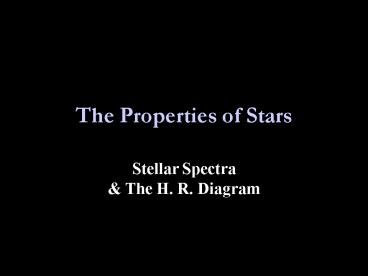The Properties of Stars - PowerPoint PPT Presentation
1 / 27
Title:
The Properties of Stars
Description:
There is a lot of information hiding in individual stellar spectra besides color! ... but that does not mass as much as that of a 'small' football sized hunk of lead. ... – PowerPoint PPT presentation
Number of Views:611
Avg rating:3.0/5.0
Title: The Properties of Stars
1
The Properties of Stars
- Stellar Spectra The H. R. Diagram
2
Stellar Spectra
- There is a lot of information hiding in
individual stellar spectra besides color! We can
also learn much about the chemical composition of
stars by investigating the spectral lines that
show up in the spectra.
3
spectral types
- Annie Jump Cannon
- Born 1863, Dover Delaware
- She developed the widely adopted classification
scheme in 1910. - Strength of Hydrogen Balmer (to n2) Lines along
with the appearance of other chemical line
features - This is a surface temperature scale based on
spectral lines features.
4
The Suns Complete Spectra!
5
(No Transcript)
6
Hertzsprung-Russell Diagram
- Ejmar Hertzsprung (1873-1967) Copenhagen
Began his career as a Chemical Engineer. While
working and independently at the same time - Henry Norris Russell (1877-1957) Princeton
Student then professor. - A graph that separates the effects of temperature
and surface area on stellar luminosities. - The HR Diagram is much like the same thing as
producing a graph of peoples height vs. weight.
7
What does the luminosity of a star depend on?
- Temperature (proportional to T4)
- Size (proportional to R2)
- Full blown formula? L4pR2sT4
8
(No Transcript)
9
Spectral Types
10
Bright
Absolute Magnitude
Luminosity
Dim
O B A F G K M
Early Types
Late Types
Hot
Cool
11
Main Sequence
- Extends from the hot, bright, bluish stars in the
upper left to cool, dim, reddish stars in the
lower right. - Size (Radius) of the stars RR (or slightly
bigger/smaller) 90 of the stars in space.
12
(No Transcript)
13
Red Giants
- Cool, luminous stars. They are very luminous
because of their large size. - Size R100R ? but they are only about 0.9 of
the stars by number.
14
Supergiants
- Exceptionally luminous extra large sized stars!
(humongous!) - Size R1000R ? but they are only about 0.1 of
the stars by number.
15
(No Transcript)
16
Where is the missing 9?
- White Dwarfs
- HOT but faint stars.
- The surface temperatures of these stars are very
hot, but since they are so small they are not
very luminous. - Size R(1/100)R RÅ ? but they are only about
0.9 of the stars by number.
17
(No Transcript)
18
Sun
G2
5,800 K
1 M
Main Sequence
Sirius B
A0
18,500 K
1 M
White Dwarf
19
Caution!
- Do not confuse the size of an object with the
mass of an object. Just because an object is
large in dimension does not necessarily mean it
is also large in mass. For example, you can have
a forty foot tall by three foot across
marshmallow that looks large, but that does not
mass as much as that of a small football sized
hunk of lead.
20
Mass Ranges of Main Sequence Stars
- Most Massive Stars 55-100(?) times more massive
than the Sun (very rare) - Least Massive Stars 0.1-0.08 times the mass of
the Sun. (very common) - This pattern stretches from the higher mass O,Bs
to lower mass K,Ms.
21
Mass-Luminosity Relationship
- The Main Sequence also exhibits a
Mass-Luminosity Relationship. Simply, a stars
location on the main sequence depends on its
mass. The more luminosity a star has the larger
its mass. The lower the stars mass the smaller
its luminosity. But this is true only on the main
sequence.
22
Bright
Absolute Magnitude
Luminosity
Dim
O B A F G K
M
23
Mass-Luminosity Relationship
Main Sequence Stars ONLY!!
L M3.5
24
Examples
- Suppose the mass of a star is 4 M then
- L (4)3.5 (4) (4) (4) (4)0.5 128 times
more luminous than Sun. - L 128 L
- Suppose the luminosity of a star is 5 L then 5
(M)3.5 ? M(5)-3.5 1.6 times more mass than
Sun. - M 1.6 M
25
Density ranges of Stars
- Sun 1.0 grams/cm3 (The same density of water!)
- Giants 0.01 grams/cm3 ? 0.1 grams/cm3
- Supergiants 0.000001 grams/cm3 (That is less
than the density of air!) - White Dwarfs 10,000,000 grams/cm3 (1
sugar-cubed size of white dwarf material would
weigh nearly 20 tons!)
26
(No Transcript)
27
(No Transcript)

